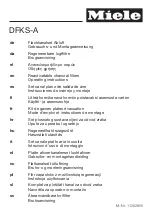
13
EN
8.
To avoid hazards, the electrical installation must be equipped with an earthing device;
9.
Make sure that the maximum pressure of the network does not exceed 8 bar; otherwise,
install a pressure reducer.
The above-mentioned manufacturer shall not be responsible for the damages and/or accidents
resulting from failure to follow these precautions.
INSTALLATION
PLACEMENT
When choosing the location to place the machine, bear in mind the following:
1.
the ambient temperature of the premises must be between 4°C and 30°C;
2.
install the water softener in a position that offers easy access for periodic refills of salt in the
brine (fig. 7);
3.
the distance between the water softener and the drain must be the minimum possible;
4.
the water softener must be installed horizontally;
5.
make sure that the connection pipes are not flattened or narrowed: the water flowing through
them must do so without finding obstacles;
6.
in the event that the water softener is close to a boiler, make sure the pipes or the water
softener itself are not overheated. If possible, maintain a distance of a few metres (at least three)
between the outlet of the water softener and the boiler inlet;
7.
Do not install the water softener close to acid or corrosive substances or fumes.
CONNECTION TO THE ELECTRICAL NETWORK
Before connecting the plug to the electrical network, check that it is compatible with the electricity
socket. The machine has been built respecting the essential safety regulations established by the
European directives: Low Voltage Directive 2006/95/EC and 93/68/EC (electrical safety); EMC
Directive 2004/108/EC and 93/68/EC (electrical safety). The installation must comply with the
regulations on electrical installations CEI 64.8.
CONNECTION TO THE WATER NETWORK
Make sure that the network pressure is between 2 and 8 bar. If it exceeds 8 bar a pressure
reducer must be installed; if it is less than 2 bar, the water softener will have operation problems.
For safety, install two taps on the inlet and outlet pipes (fig. 3, B, D) allowing you to stop the flow
of water.
On the outlet pipe (fig. 3, A) install a non-return valve (DVGW, DIN 1988 T2), to avoid possible
returns of hot water to the water softener, which could damage it.
We recommend the installation described in fig. 3, which will allow you to use water in the
installation, also when the maintenance of the water softener must be carried out. When the
installation is complete, before opening the inlet and outlet taps, the water softener must be
started (see section 11).
CONNECTION TO THE DRAINAGE NETWORK
The water flowing from the drain outlet during the regeneration must flow through the flexible
plastic tube (included in the box) to the nearest drain. Install the drainage pipe reading the
following indications, an improper installation will cause the water softener to operate incorrectly:
•
the discharge point must be, if possible, at ground level;
•
if the discharge point is higher than the water softener, a maximum height of 1.8 metres is
permitted provided that the pipe does not exceed 5 metres in length and the network pressure is
at a minimum of 2.8 bar (fig. 5);
Содержание DS-12
Страница 52: ...52 PT...
Страница 61: ...61 PT...
Страница 67: ......
Страница 68: ...ER 437 1 96 UNE EN ISO 9001 SAMMIC S L Sociedad Unipersonal Basarte 1 20720 AZKOITIA www sammic com 06 10 0...














































